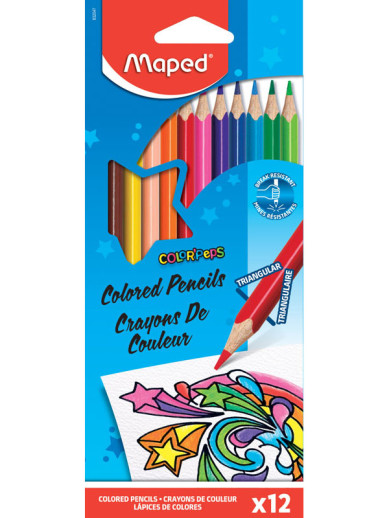We use cookies to make your experience better. To comply with the new e-Privacy directive, we need to ask for your consent to set the cookies. Learn more.
Color Pep's Colored Pencils (Pack of 12)
Being a color pencil connoisseur, I was skeptical when I opened up this box. That is, until I used them. Wow! The colors are vividly rich and the lead is soft and smooth. I was amazed at the way the colors softly glided across the paper with minimal effort. The lead is break resistant and the pencils are easy to sharpen, plus the triangular shaped pencils are easy to hold with a comfortable grip. The wood is from sustainably grown forests.
Bright colored pencils with soft and resilient lead, provide smooth coloring and blending fun! Ergonomically designed with a triangular shape for the utmost drawing comfort and the perfect grip. Standard pencils have a 2.9mm core, while the Jumbo pencils have a 4.7mm core which is perfect for young students learning to color! Sharpens easily in all standard pencil sharpeners. Classpacks contain free bonus sharpeners and include the following 12 colors: Dark Black, Woody Brown, Green Golf, Apple Green, Sunny Yellow, Blush, Fuity Orange, Red Kiss, Lovely Pink, Aubergine (Purple), Marina Blue & Bubble Blue.
| Product Format: | Other |
|---|---|
| Grades: | K-12 |
| Brand: | Maped |
| EAN/UPC: | 3154148320470 |
| Length in Inches: | 8 |
| Width in Inches: | 3.5 |
| Height in Inches: | 0.25 |
| Weight in Pounds: | 0.15 |
Be the first to review this item
- Start typing and we'll see if it was already asked and answered.
- If there aren't already some matches, submit a new question.
- You'll get fast answers from customers who really own the item(s) and from our product experts. (About half the time you'll get an answer in under 2 hours!)
- Which items will best meet your needs
- What customers who own an item think of it
- How to use, fix, or take care of an item
- Product information
- General advice related to the types of products we sell
- Our store policies
For questions about an order you have placed, please contact customer support directly.

















I love colored pencils and she will too
I like the triangle shape and read they were good pencils. also a very good price.
I chose these because of the description saying they were great pencils that flowed well on paper. I'm picky about my pencils so am looking forward to trying these!